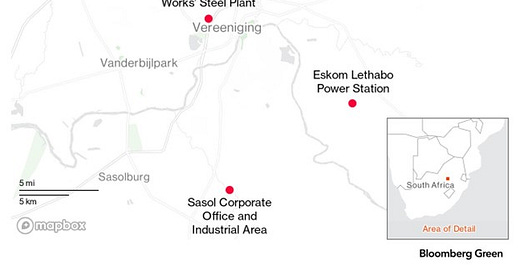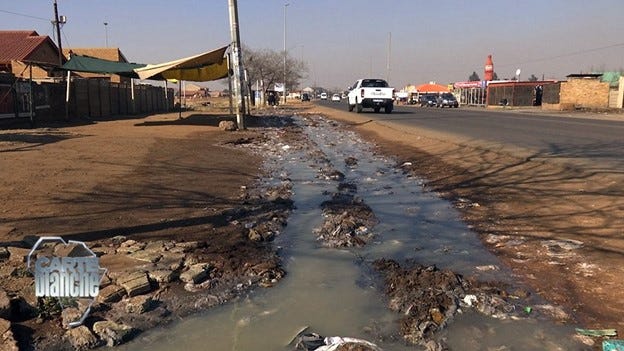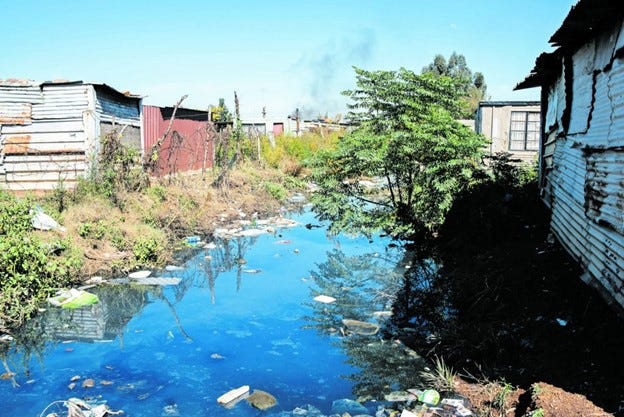[Before you read the main post, in March this year I wrote about the August 2023 fire on the island of Maui, Hawaii. The link is here.
Earlier this week the Attorney General of Hawaii released the first phase of a report into the deadly fire that struck the town of Lahaina on the island of Maui in August 2023. The report confirmed that the fire originated from downed electrical wires falling on to dry grasses. Once started, the fire spread rapidly driven by strong winds. There was no direct link to climate change.
1,900 subscribers now. Welcome all.]
50km south of Johannesburg sits the Vaal Triangle, home to 1.7 million people alongside Africa’s biggest steel mill, a giant coal-fired power plant, an oil refinery, and a petrochemicals complex. One town in the area, Vereeniging, regularly registers the highest levels of harmful particulate emissions on the planet.
The Vaal Triangle
The Vall Triangle (Figure 1) is an area formed by the towns of Vereeniging, Vanderbijlpark, and Sasolburg. This region constitutes a significant urban area. The districts of Sharpeville, Boipatong, Bophelong, the greater Sebokeng area (including Evaton and Orange Farm), Three Rivers, Heidelberg, Deneysville, and Potchefstroom are also generally considered to be part of the Vaal Triangle.
Figure 1. The Vaal triangle
The Vaal Triangle straddles the Vaal River and is a major industrial hub. It is home to ArcelorMittal SA, which operates steel facilities, and Sasol, known for its petrochemical processing plants. Unfortunately, due to the heavy industries in and around the Vaal Triangle, the region has become infamous for its air pollution and associated respiratory diseases. Locally, Afrikaans-speaking people often sarcastically refer to the region as the Vuil Driehoek (meaning ‘Dirty Triangle’) as a play on words with ‘Vaal Driehoek’ (the Afrikaans translation for Vaal Triangle).
Nearby is the Vaal Dam, a water reservoir from which the massive PMV urban mega-area (comprising Pretoria, Witwatersrand, and Vereeniging) draws its water. The PWV forms the urban heart of Gauteng province. The Witwatersrand, known for its gold-bearing reef where gold was discovered in 1886, is also part of this dynamic region. The Vaal Dam is a popular destination for water recreation, attracting visitors from Johannesburg and beyond, especially during weekends and holidays.
In 2005, the region was designated as the country’s first ‘Airshed Priority Area’ with a commitment that pollution would be tackled. 20 years later, air quality levels are much the same. In some areas, cash-strapped authorities have stopped collecting waste, forcing residents to burn it, worsening the problem. Some say this is the result of the failure by the federal government, led by the African National Congress (ANC), to enforce existing laws and pass new ones to protect its people. The companies - ArcelorMittal, Sasol, and Eskom - have won exemptions to emissions limits by playing on concerns about unemployment that is high and worsening.
The future
With elections on May 29, 2024, threatening to remove the ANC’s parliamentary majority, the government is split over this dilemma: how to wean a carbon-dependent economy off the dirtiest fossil fuel - coal. President Cyril Ramaphosa and his environment minister advocate a transition to clean power. However, his energy and electricity ministers paint this as a Western plot that will drive more people across the coal belt, an ANC heartland, out of work and worsen already crippling national power outages. Government scientists are currently examining millions of death certificates and are expected to report just how many people have been killed by the fossil fuel.
So, while the Vaal Triangle has a rich industrial history, it also faces environmental and political challenges.
Figure 2. Images of the Vaal Triangle






